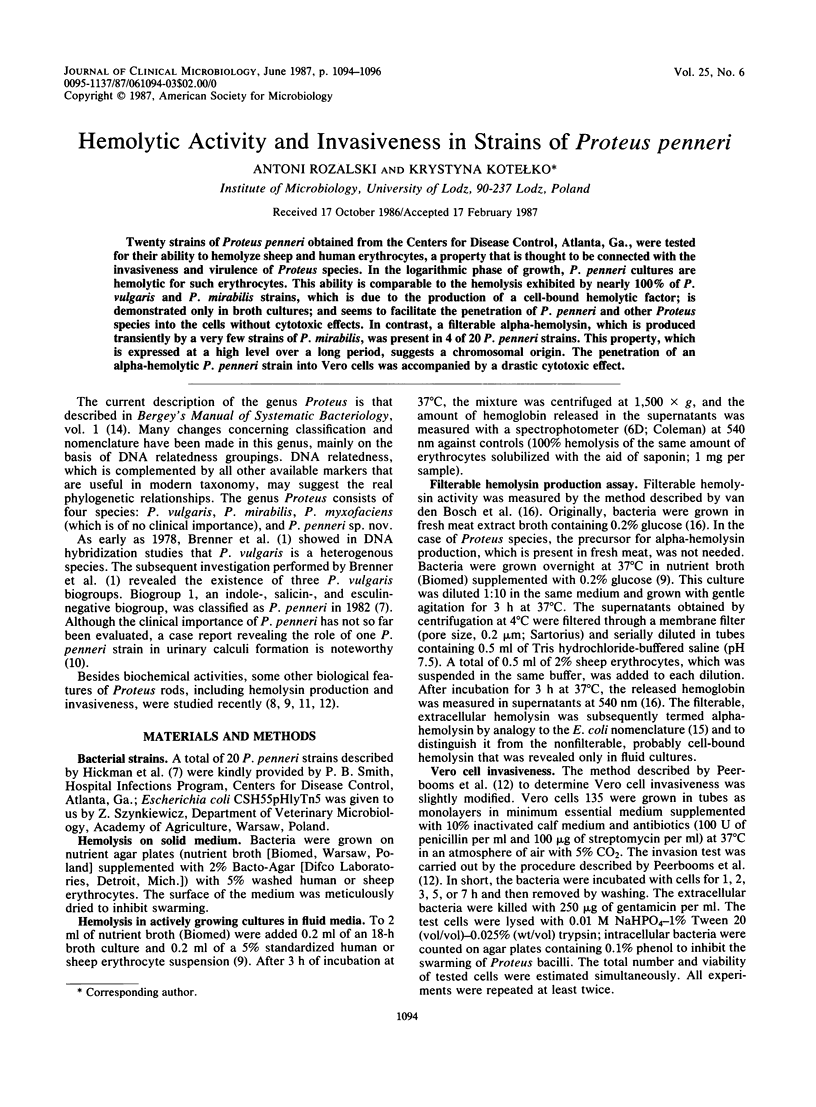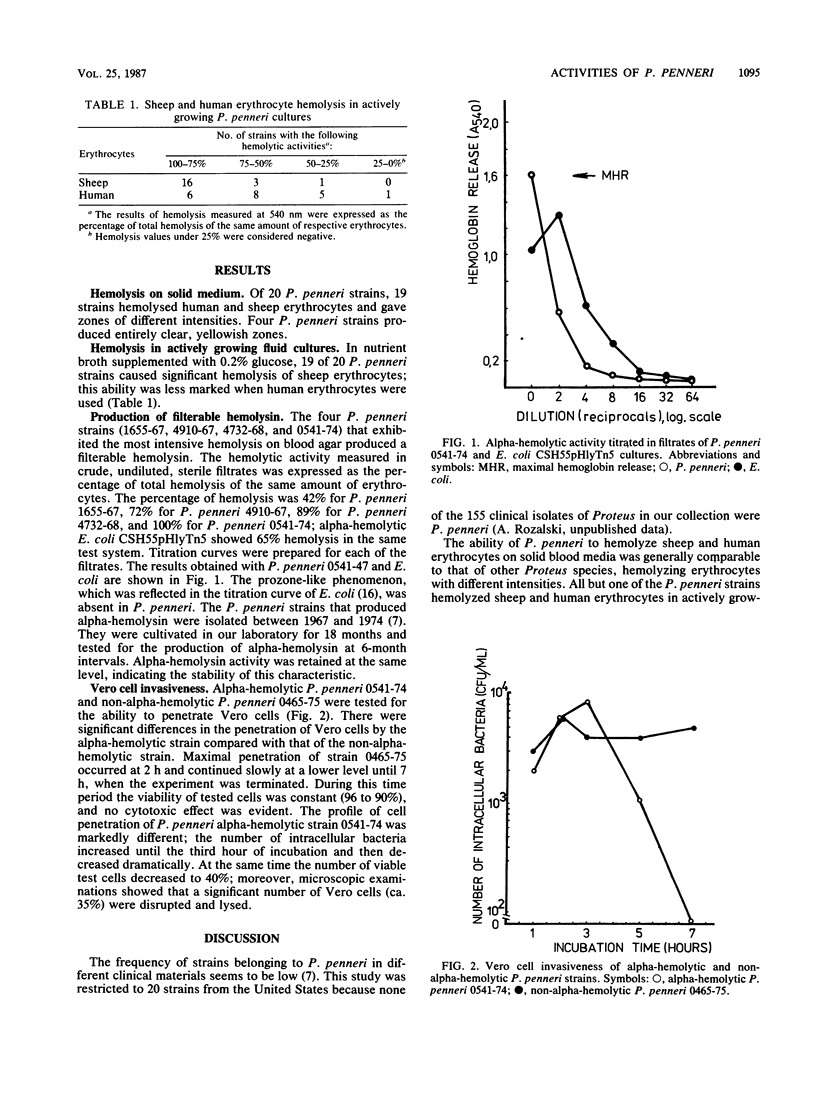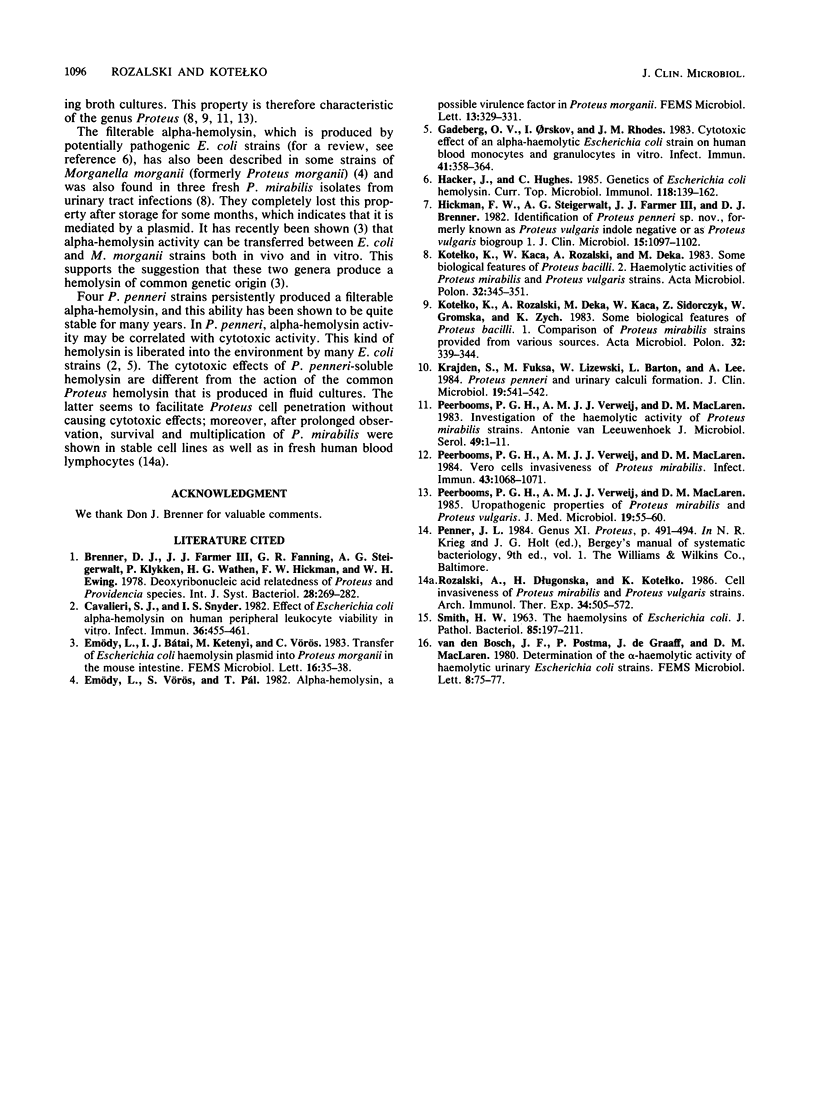Abstract
Twenty strains of Proteus penneri obtained from the Centers for Disease Control, Atlanta, Ga., were tested for their ability to hemolyze sheep and human erythrocytes, a property that is thought to be connected with the invasiveness and virulence of Proteus species. In the logarithmic phase of growth, P. penneri cultures are hemolytic for such erythrocytes. This ability is comparable to the hemolysis exhibited by nearly 100% of P. vulgaris and P. mirabilis strains, which is due to the production of a cell-bound hemolytic factor; is demonstrated only in broth cultures; and seems to facilitate the penetration of P. penneri and other Proteus species into the cells without cytotoxic effects. In contrast, a filterable alpha-hemolysin, which is produced transiently by a very few strains of P. mirabilis, was present in 4 of 20 P. penneri strains. This property, which is expressed at a high level over a long period, suggests a chromosomal origin. The penetration of an alpha-hemolytic P. penneri strain into Vero cells was accompanied by a drastic cytotoxic effect.
Full text
PDF


Selected References
These references are in PubMed. This may not be the complete list of references from this article.
- Cavalieri S. J., Snyder I. S. Effect of Escherichia coli alpha-hemolysin on human peripheral leukocyte viability in vitro. Infect Immun. 1982 May;36(2):455–461. doi: 10.1128/iai.36.2.455-461.1982. [DOI] [PMC free article] [PubMed] [Google Scholar]
- Gadeberg O. V., Orskov I., Rhodes J. M. Cytotoxic effect of an alpha-hemolytic Escherichia coli strain on human blood monocytes and granulocytes in vitro. Infect Immun. 1983 Jul;41(1):358–364. doi: 10.1128/iai.41.1.358-364.1983. [DOI] [PMC free article] [PubMed] [Google Scholar]
- Hacker J., Hughes C. Genetics of Escherichia coli hemolysin. Curr Top Microbiol Immunol. 1985;118:139–162. doi: 10.1007/978-3-642-70586-1_8. [DOI] [PubMed] [Google Scholar]
- Hickman F. W., Steigerwalt A. G., Farmer J. J., 3rd, Brenner D. J. Identification of Proteus penneri sp. nov., formerly known as Proteus vulgaris indole negative or as Proteus vulgaris biogroup 1. J Clin Microbiol. 1982 Jun;15(6):1097–1102. doi: 10.1128/jcm.15.6.1097-1102.1982. [DOI] [PMC free article] [PubMed] [Google Scholar]
- Kotelko K., Kaca W., Rózalski A., Deka M. Some biological features of Proteus bacilli. 2. Haemolytic activities of Proteus mirabilis and Proteus vulgaris strains. Acta Microbiol Pol. 1983;32(4):345–351. [PubMed] [Google Scholar]
- Kotelko K., Rozalski A., Deka M., Kaca W., Sidorczyk Z., Gromska W., Zych K. Some biological features of Proteus bacilli. 1. Comparison of Proteus mirabilis strains provided from various sources. Acta Microbiol Pol. 1983;32(4):339–344. [PubMed] [Google Scholar]
- Krajden S., Fuksa M., Lizewski W., Barton L., Lee A. Proteus penneri and urinary calculi formation. J Clin Microbiol. 1984 Apr;19(4):541–542. doi: 10.1128/jcm.19.4.541-542.1984. [DOI] [PMC free article] [PubMed] [Google Scholar]
- Peerbooms P. G., Verweij A. M., MacLaren D. M. Investigation of the haemolytic activity of Proteus mirabilis strains. Antonie Van Leeuwenhoek. 1983 Apr;49(1):1–11. doi: 10.1007/BF00457874. [DOI] [PubMed] [Google Scholar]
- Peerbooms P. G., Verweij A. M., MacLaren D. M. Uropathogenic properties of Proteus mirabilis and Proteus vulgaris. J Med Microbiol. 1985 Feb;19(1):55–60. doi: 10.1099/00222615-19-1-55. [DOI] [PubMed] [Google Scholar]
- Peerbooms P. G., Verweij A. M., MacLaren D. M. Vero cell invasiveness of Proteus mirabilis. Infect Immun. 1984 Mar;43(3):1068–1071. doi: 10.1128/iai.43.3.1068-1071.1984. [DOI] [PMC free article] [PubMed] [Google Scholar]
- Rózalski A., Długońska H., Kotełko K. Cell invasiveness of Proteus mirabilis and Proteus vulgaris strains. Arch Immunol Ther Exp (Warsz) 1986;34(5-6):505–512. [PubMed] [Google Scholar]
- SMITH H. W. The haemolysins of Escherichia coli. J Pathol Bacteriol. 1963 Jan;85:197–211. doi: 10.1002/path.1700850119. [DOI] [PubMed] [Google Scholar]


